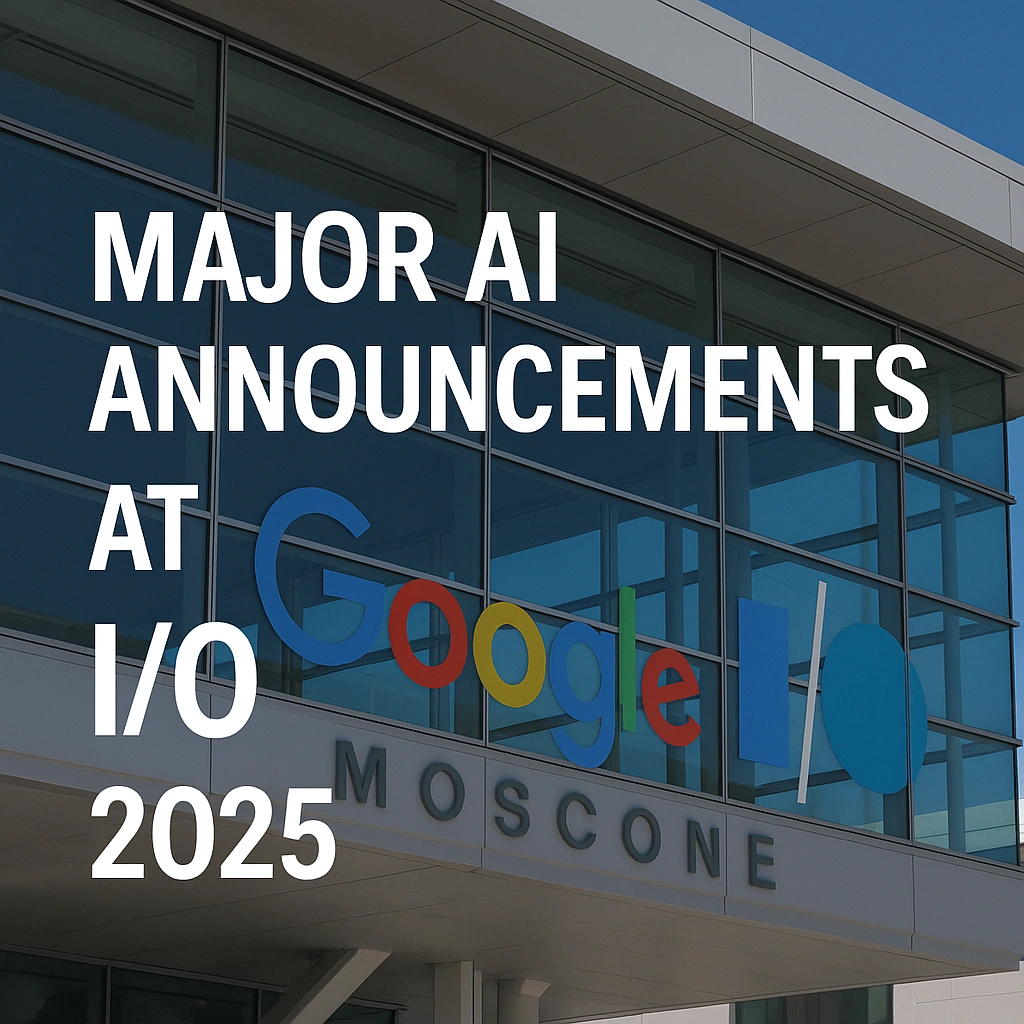On May 6, 2025, Google’s annual I/O conference showcased a sweeping set of AI innovations. From next-generation language models to energy-smart solutions and even dolphin communication, Google unveiled tools designed to empower developers, businesses, and society at large. These announcements highlight Google’s drive to push AI boundaries, promote open collaboration, and address real-world challenges. Here’s an in-depth look at each announcement and why it matters.
Gemini 2.5 Pro Preview (I/O Edition)
Unmatched Coding Power
Google introduced Gemini 2.5 Pro Preview (I/O Edition), its most advanced coding model yet. It “significantly” improves on code generation, transformation, and editing tasks. Early benchmarks place it at No. 1 on LMArena for coding and No. 1 on the WebDev Arena Leaderboard for building interactive web apps. This means developers can rely on Gemini to scaffold complex applications faster and with higher accuracy.
Superior Video Understanding
Beyond code, Gemini 2.5 Pro now excels at video comprehension. On the popular VideoMME benchmark, it scores 84.8%, enabling richer analysis of multimedia content—ideal for creating tutorials, automated summaries, and more.
Seamless Access Across Platforms
Gemini 2.5 Pro Preview is available publicly via the Gemini API, Vertex AI, AI Studio, and the Gemini mobile app. This broad rollout ensures both individual creators and large enterprises can integrate its capabilities into their workflows immediately.
Ironwood TPU: Powering Next-Gen AI
Record-Breaking Performance
Google unveiled Ironwood, its seventh-generation Tensor Processing Unit (TPU). This chip boosts AI training and inference speeds by leaps and bounds compared to its predecessors. Built for efficiency, Ironwood delivers high performance with lower energy consumption—helping organizations scale AI workloads sustainably.
Enterprise-Ready Scalability
Ironwood TPUs will be accessible through Google Cloud, enabling businesses to tap into exaflop-class computing on demand. From AI research to production pipelines, enterprises gain a competitive edge with faster model iteration and deployment.
Agent2Agent (A2A) Protocol: Collaborative AI Agents
A Universal Agent Language
Google launched Agent2Agent, an open protocol that lets AI agents—regardless of framework or vendor—communicate and collaborate seamlessly. By defining a common message format and interaction rules, A2A unlocks new possibilities for multi-agent systems, such as task orchestration and data exchange.
Cross-Platform Innovation
With Agent2Agent, developers can mix and match best-in-class agents (e.g., language models, vision systems, and domain-specific bots) into unified workflows. This fosters a vibrant ecosystem where innovation thrives without silos.
Expanded Image Editing in the Gemini App
AI-Powered Creative Control
Building on AI Studio’s earlier success, the Gemini app now offers in-app editing for both AI-generated and user-uploaded images. Users can refine compositions, adjust styles, and apply transformations—all powered by Google’s advanced generative models.
Intuitive, Mobile-First Experience
Designed for on-the-go creativity, these editing tools feature drag-and-drop masks, prompt-based style tweaks, and one-tap background swaps. The result is a mobile app that empowers anyone to produce compelling visuals without complex software.
AI for the U.S. Electric Grid
Optimizing Power Generation
In partnership with PJM Interconnection (North America’s largest grid operator) and Tapestry, Google is deploying AI to monitor and optimize electricity flow. These solutions predict demand patterns, balance supply, and reduce waste—strengthening grid reliability and lowering costs for utilities and consumers.
Toward a Sustainable Energy Future
By integrating machine learning with real-time data from sensors and weather forecasts, Google’s AI helps grid managers make faster, data-driven decisions. This not only reduces blackout risks but also accelerates the integration of renewables.
Google AI I/O 2025: AI Policy and Workforce Funding
Equipping Tomorrow’s Workforce
Recognizing that technology must go hand-in-hand with talent, Google.org committed to funding the training of 100,000 electrical workers and 30,000 apprentices in the U.S. This initiative aims to build a skilled workforce ready for AI-driven transformation in the energy sector.
Policy Roadmap for AI in Energy
Alongside funding, Google released policy recommendations to guide federal and state leaders on supporting infrastructure upgrades, data privacy, and equitable access. These guidelines are designed to ensure AI benefits are broadly shared across communities.
DolphinGemma: Decoding Dolphin Communication
Bridging Species with AI
In collaboration with Georgia Tech and the Wild Dolphin Project, Google unveiled DolphinGemma, an open-source model trained on extensive dolphin acoustic recordings. This tool helps researchers map vocal patterns, identify social calls, and even synthesize novel dolphin-like sounds.
Advancing Marine Science
By applying deep learning to marine bioacoustics, DolphinGemma accelerates studies on dolphin behavior, population health, and environmental impact—opening new frontiers in ocean conservation.
Sec-Gemini v1: Strengthening Cybersecurity Defenses
AI-Driven Threat Analysis
Google introduced Sec-Gemini v1, an experimental AI model that assists cybersecurity professionals in detecting vulnerabilities, triaging alerts, and automating routine defenses. This “force multiplier” helps tip the balance in favor of defenders in an ever-evolving threat landscape.
Real-World Impact
Early tests show Sec-Gemini v1 can reduce mean time to detection and response by rapidly correlating disparate data sources, such as network logs and threat intelligence feeds. This translates to fewer breaches and faster incident resolution.
Conclsuion: A Future Powered by AI
Google’s announcements on May 6 demonstrate a multi-dimensional AI strategy. By advancing core models like Gemini, investing in cutting-edge hardware, fostering open protocols, and applying AI to societal challenges—from energy to marine science—Google is charting a roadmap for responsible, impactful innovation. These tools are now available for you to explore, integrate, and build upon. Together, we can harness AI’s potential to create a more efficient, sustainable, and connected world.
Empower your next project with these AI breakthroughs and join Google’s vision for an AI-driven future.
